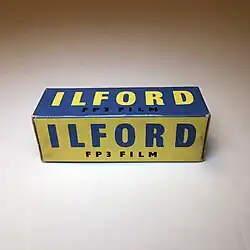| FP4 |
|---|
| Speed | 125 ASA |
|---|
| Type | B&W |
|---|
| Introduced | 1968 |
|---|
| Discontinued | 1990 |
|---|
| Replaced by | FP4 plus |
|---|
| FP3 |
|---|
 |
| Speed | 64 ASA, 125 ASA (1960) |
|---|
| Type | B&W |
|---|
| Introduced | 1942 |
|---|
| Discontinued | 1968 |
|---|
| Replaced by | FP4 |
|---|
| FP2 |
|---|
| Speed | 40 ASA |
|---|
| Type | B&W |
|---|
| Introduced | 1939 |
|---|
| Discontinued | 1942 |
|---|
| Replaced by | FP3 |
|---|
| FP |
|---|
| Speed | 40 ASA |
|---|
| Type | B&W |
|---|
| Introduced | 1935 |
|---|
| Discontinued | 1939 |
|---|
| Replaced by | FP2 |
|---|
FP is a cubic-grain[2] black-and-white film from Ilford Photo with a long history.[3] It originated as Fine grain Panchromatic roll film in 1935. Like its faster partner product, HP film, it has gone through a number of versions since then, with the latest being FP4 plus (FP4+ for short).
The film is known for being versatile, with usable results even when underexposed two stops or overexposed six stops.[1] This is due to the fact that FP4 features a double layer emulsion. It combines a layer of low sensitivity fine grain particles and a high sensitivity larger grained layer. This kind of film was already known in the 1920s and 1930s (e.g. Agfa Isopan F 17/10° DIN). Being perfect for the amateur's 6x9 roll film cameras these old types lacked sharpness in the 24 x 36 mm format due to the overall thickness of both layers. But the FP4 of 1968 combined an amateur-friendly double layer emulsion with the sharpness of a typical thin layer emulsion. This was possible because both layers together were only 7.5 μm thick.[4]
References
External links

